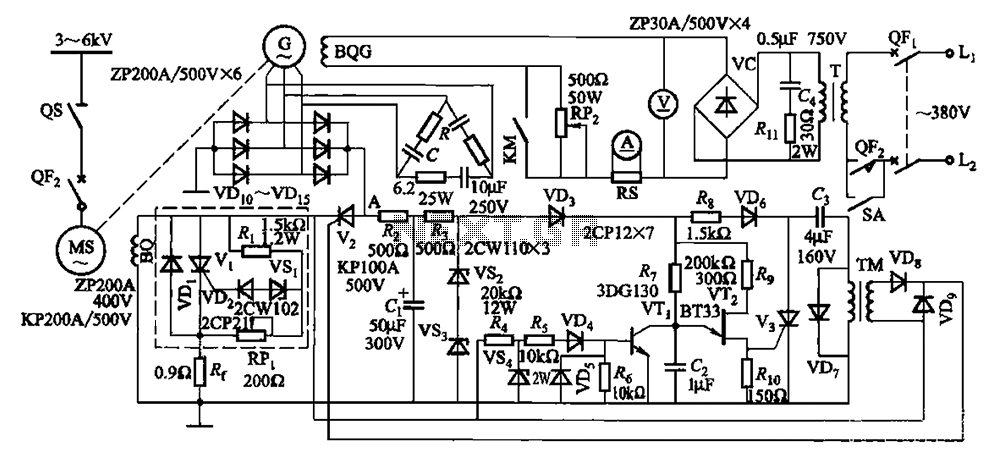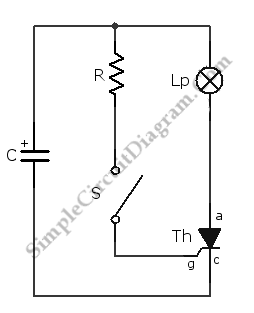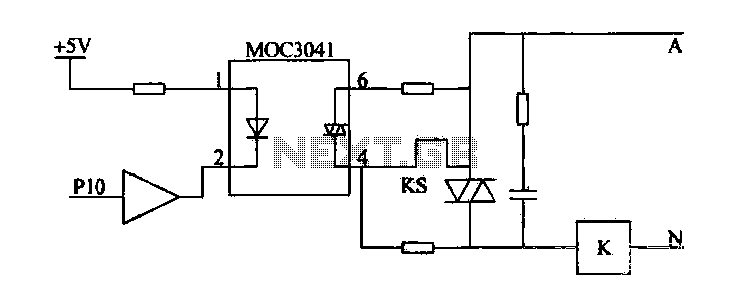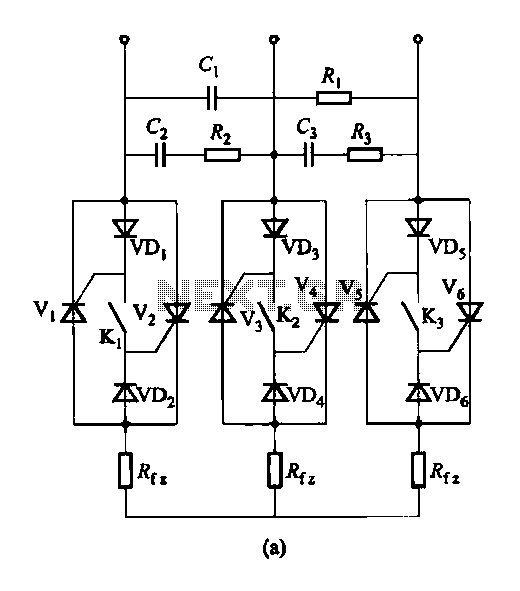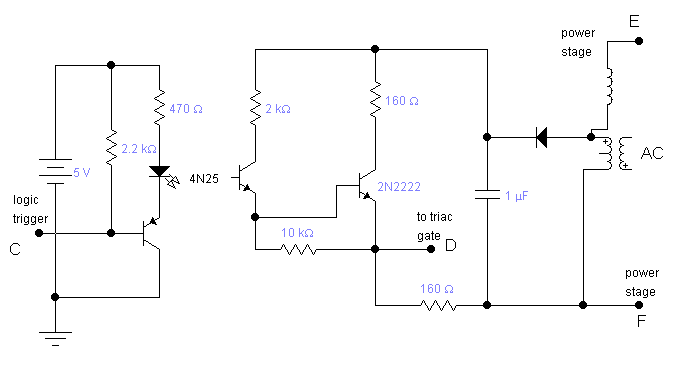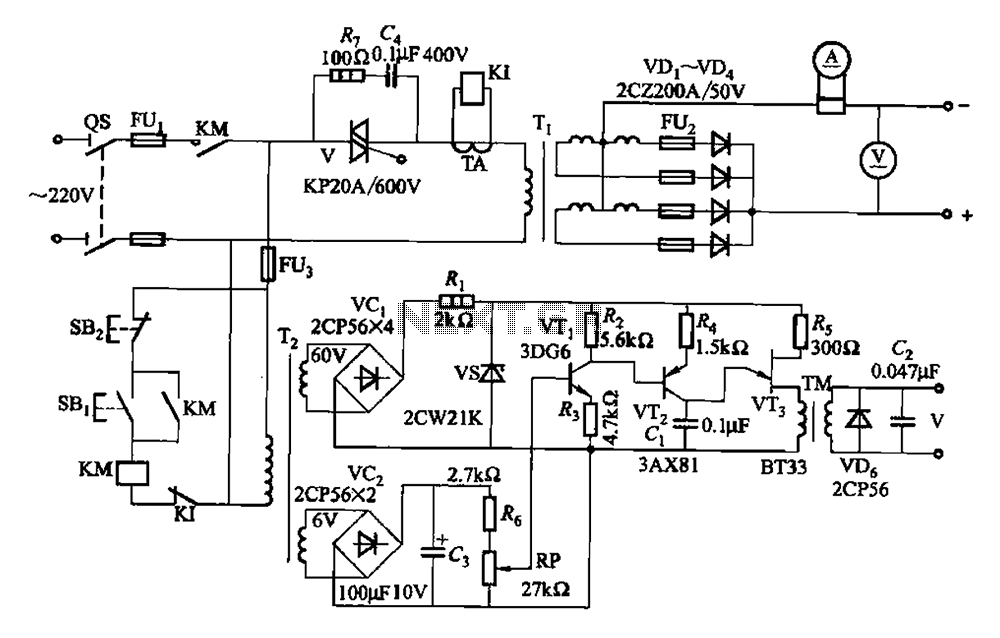
thyristor
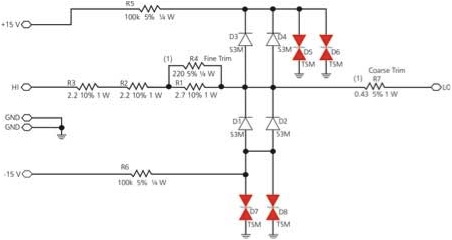
A thyristor functions similarly to a diode, allowing current to flow in a forward direction while blocking it in reverse. The key distinction is that a thyristor is a three-terminal device comprising an anode, cathode, and gate, which prevents current flow in the forward direction until the gate is signaled to activate. Once triggered, the gate signal can be removed, and the thyristor remains in the 'on' state until the current through it drops to zero, which typically occurs during each cycle of the main supply. Thyristors are commonly referred to as Silicon Controlled Rectifiers (SCRs), Triacs, Thyristor Surge Protective Devices, SIDACs, and Programmable Unijunction Transistors (PUTs). Despite their various forms, they share common characteristics. They are normally-off switches, meaning a small current pulse into the gate can trigger them. Once activated, they remain conductive even after the gate signal is removed, reverting to the off state only when the current falls below a minimum threshold or when the current direction reverses. The circuit symbol illustrates that in the absence of gate current, the device remains non-conducting and can withstand both positive and negative bias voltages. Coilgun thyristors are preferred for basic capacitor discharge applications, as they can hold off capacitor voltage until triggered, allowing the capacitor to discharge through the thyristor into the coil. Thyristors also play a critical role in despiking AC lines, where they are used on the primary side of transformers to eliminate voltage spikes. This application enhances controllability and has historically replaced mercury-arc valves in robust AC/DC converters, reducing conversion losses and enabling rapid power control. Thyristors can achieve zero current quickly, facilitating fault isolation without circuit breakers. In schematics, thyristors are positioned at the edge of conduction, responding in nanoseconds to limit voltage spikes passed to instrumentation amplifiers. As thyristors conduct, the voltage drop occurs across resistors R1-4, protecting circuits from high-energy pulses. Energy-absorbing circuits are designed to shunt voltages exceeding 16 V swiftly, with minimal circuit loading performed by thyristors D5-8. To ensure rapid response and low capacitive loading, these thyristors are biased near their trigger point using +15 V and -15 V supply rails. Back-biased diodes D1-4 isolate the supply rails from the circuit under normal conditions, preventing leakage current in the thyristors from affecting the signal line. These protection circuits are essential for sensitive circuits to divert unintended energy spikes, ensuring the reliability of the interface, especially following failures of the ICD under test.
Thyristors are integral components in various electronic applications due to their unique ability to control current flow with precision. Their three-terminal structure allows for versatile integration into circuits where controlled rectification is necessary. In power electronics, they enable efficient conversion and management of electrical energy, making them suitable for use in applications ranging from motor control to power supplies.
The thyristor's ability to remain in a conducting state without continuous gate activation presents advantages in applications where power efficiency is critical. For instance, in coilgun designs, the thyristor facilitates rapid discharge of energy stored in capacitors, enhancing performance by delivering high peak currents to the coil. This characteristic is particularly beneficial in pulsed power applications, where precise timing and control over energy delivery are paramount.
In protective circuitry, thyristors serve as crucial elements in surge protection systems. By quickly responding to voltage spikes, they safeguard sensitive components from damage, thereby enhancing the overall reliability of electronic systems. The design of thyristor-based protection circuits often includes strategic placement of resistors and diodes to manage voltage levels and prevent unwanted current flow, ensuring that the circuit operates within safe parameters.
Overall, thyristors are versatile and essential components in modern electronics, providing reliable control over electrical power and protecting sensitive circuits from transient disturbances. Their application in various fields demonstrates their importance in advancing electronic technology and improving system performance.A thyristor is like a diode; it can pass electricity in a forward direction but, blocks it in a reverse direction. The difference between a diode and a thyristor is that the thyristor is a three terminal device consisting of an anode, cathode and gate, which will also block current flow in the forward direction until it`s gate is signaled to open
or, to use more technical jargon, the thyristor is fired . Once turned on, the gate signal is removed and the thyristor remains on until the current through it drops to zero, which conveniently happens during each cycle of the main supply. Thyristors are most commonly known as Silicon Controlled Rectifiers (SCRs), Triacs, Thyristor Surge Protective Devices & SIDACs, and Programmable Unijunction Transistor (PUT).
Although it can take many forms, they all have certain things in common. Normally-off switches, a small current pulse into the gate electrode can trigger thyristors on . Once triggered, the component then stays in the conducting state even when the gate on signal is removed. It only returns to the off (blocking) state if the current falls below a certain minimum or if the direction of the current is reversed.
The circuit symbol is shown below. When there is no gate current, the device is in the non-conducting state and will hold off positive and negative bias voltages. The zero gate current characteristic is: Coilgun Thyristors are the device of choice when using a basic capacitor discharge coilgun.
The thyristor will hold off the capacitor voltage until it is triggered into the forward conduction zone by the gate current signal. The capacitor then discharges through the thyristor into the coil and the current decays to zero. There is no option for turning off the current once the device is conducting. *Coilguns have no industrial application use* Despike ac lines (snubber circuit) Alternating current transmission lines are susceptible to spikes.
Using thyristors on the primary side of a transformer eliminates spiking. The purpose of using thyristors to despike the voltage (dv/dt) is for enhanced controllability. Historically, replacement of mercury-arc valves by thyristors yielded robust ac/ dc converters, minimized conversion losses, and yielded fast control on transmitted power ”so much so that line-to-ground fault clearing became possible without the use of circuit breakers. Instead, by rapidly attaining zero current through the use of current controllers and, in addition, by rapidly recovering the electromagnetic energy stored in the energized line, the faulted dc line could be isolated by low interruption rating isolators.
To wit, if the voltage rate of rise is great enough (high enough), the thyristors will turn on controlling the current without interruption. Shown in the schematic, the thyristors are kept at the edge of conduction, which respond in nanoseconds to limit the spike passed into the instrumentation amplifier inputs to a few volts.
As the thyristors conduct, the voltage is dropped across resistors R1-4. The use of these thyristors protects circuits to limit the damaging effects of errant high-energy pulses resulting from either test equipment or ICD malfunction. The solution is a set of energy-absorbing circuits set to shunt voltages of more than 16 V quickly, while minimally loading the circuit.
Shunting is performed by thyristors D5-8. To ensure quick action and minimal capacitive loading, they are held at a bias voltage near their trigger point by supply rails at +15 V and -15 V. The back-biased diodes D1-4 isolate the rails from the circuit under normal conditions and prevent leakage current in the thyristors from loading the signal line.
These protection circuits are applied on sensitive circuits to divert unintentional energy (spikes). Without them, the reliability of the interface would be in question after any failure of an ICD under test. A similar but simpler protection circuit 🔗 External reference
Thyristors are integral components in various electronic applications due to their unique ability to control current flow with precision. Their three-terminal structure allows for versatile integration into circuits where controlled rectification is necessary. In power electronics, they enable efficient conversion and management of electrical energy, making them suitable for use in applications ranging from motor control to power supplies.
The thyristor's ability to remain in a conducting state without continuous gate activation presents advantages in applications where power efficiency is critical. For instance, in coilgun designs, the thyristor facilitates rapid discharge of energy stored in capacitors, enhancing performance by delivering high peak currents to the coil. This characteristic is particularly beneficial in pulsed power applications, where precise timing and control over energy delivery are paramount.
In protective circuitry, thyristors serve as crucial elements in surge protection systems. By quickly responding to voltage spikes, they safeguard sensitive components from damage, thereby enhancing the overall reliability of electronic systems. The design of thyristor-based protection circuits often includes strategic placement of resistors and diodes to manage voltage levels and prevent unwanted current flow, ensuring that the circuit operates within safe parameters.
Overall, thyristors are versatile and essential components in modern electronics, providing reliable control over electrical power and protecting sensitive circuits from transient disturbances. Their application in various fields demonstrates their importance in advancing electronic technology and improving system performance.A thyristor is like a diode; it can pass electricity in a forward direction but, blocks it in a reverse direction. The difference between a diode and a thyristor is that the thyristor is a three terminal device consisting of an anode, cathode and gate, which will also block current flow in the forward direction until it`s gate is signaled to open
or, to use more technical jargon, the thyristor is fired . Once turned on, the gate signal is removed and the thyristor remains on until the current through it drops to zero, which conveniently happens during each cycle of the main supply. Thyristors are most commonly known as Silicon Controlled Rectifiers (SCRs), Triacs, Thyristor Surge Protective Devices & SIDACs, and Programmable Unijunction Transistor (PUT).
Although it can take many forms, they all have certain things in common. Normally-off switches, a small current pulse into the gate electrode can trigger thyristors on . Once triggered, the component then stays in the conducting state even when the gate on signal is removed. It only returns to the off (blocking) state if the current falls below a certain minimum or if the direction of the current is reversed.
The circuit symbol is shown below. When there is no gate current, the device is in the non-conducting state and will hold off positive and negative bias voltages. The zero gate current characteristic is: Coilgun Thyristors are the device of choice when using a basic capacitor discharge coilgun.
The thyristor will hold off the capacitor voltage until it is triggered into the forward conduction zone by the gate current signal. The capacitor then discharges through the thyristor into the coil and the current decays to zero. There is no option for turning off the current once the device is conducting. *Coilguns have no industrial application use* Despike ac lines (snubber circuit) Alternating current transmission lines are susceptible to spikes.
Using thyristors on the primary side of a transformer eliminates spiking. The purpose of using thyristors to despike the voltage (dv/dt) is for enhanced controllability. Historically, replacement of mercury-arc valves by thyristors yielded robust ac/ dc converters, minimized conversion losses, and yielded fast control on transmitted power ”so much so that line-to-ground fault clearing became possible without the use of circuit breakers. Instead, by rapidly attaining zero current through the use of current controllers and, in addition, by rapidly recovering the electromagnetic energy stored in the energized line, the faulted dc line could be isolated by low interruption rating isolators.
To wit, if the voltage rate of rise is great enough (high enough), the thyristors will turn on controlling the current without interruption. Shown in the schematic, the thyristors are kept at the edge of conduction, which respond in nanoseconds to limit the spike passed into the instrumentation amplifier inputs to a few volts.
As the thyristors conduct, the voltage is dropped across resistors R1-4. The use of these thyristors protects circuits to limit the damaging effects of errant high-energy pulses resulting from either test equipment or ICD malfunction. The solution is a set of energy-absorbing circuits set to shunt voltages of more than 16 V quickly, while minimally loading the circuit.
Shunting is performed by thyristors D5-8. To ensure quick action and minimal capacitive loading, they are held at a bias voltage near their trigger point by supply rails at +15 V and -15 V. The back-biased diodes D1-4 isolate the rails from the circuit under normal conditions and prevent leakage current in the thyristors from loading the signal line.
These protection circuits are applied on sensitive circuits to divert unintentional energy (spikes). Without them, the reliability of the interface would be in question after any failure of an ICD under test. A similar but simpler protection circuit 🔗 External reference
